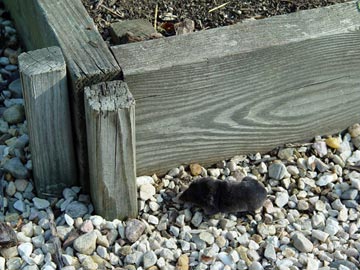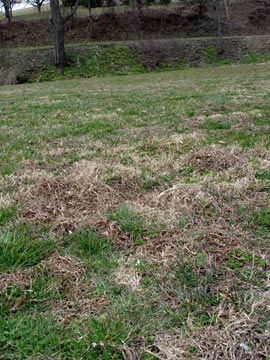 Voles are underrated as garden pests because these mouse-like critters are shy and seldom seen in action.
Voles are underrated as garden pests because these mouse-like critters are shy and seldom seen in action.
© George Weigel
Little rodents can cause big damage in the landscape. Arguably the most destructive animal pest per ounce is the vole, a dark-brown rodent about the size of a field mouse. Often confused with moles, a single 5-inch-long vole is capable of killing a 40-foot-tall mature tree by chewing a band of bark the whole way around the tree’s base. Voles are particularly destructive in winter when their diet turns from green, in-season vegetation to plant roots, the bark of trees and shrubs (especially young ones), and those wholesome tulip bulbs that you lovingly planted in October.
Voles also are the critters that leave behind those curving surface tunnels in the lawn at winter’s end. Under protection of snow cover, normally shy voles venture out into the open in search of food without fear of being picked off by predator hawks and owls. While moles are better known, voles are by far the worse headache for gardeners. That’s because voles are vegetarians while moles are primarily meat-eaters that feed on earthworms, insects, and their snack of choice, beetle grubs nestled in the ground.
You could make the argument that moles are actually beneficial in the yard, were it not for their messy lifestyle habits of tearing up lawns in search of grubs, causing long raised mounds in the lawn above where they’re tunneling, or building 8-inch tall dirt volcanos at the entrance to their underground abodes. Voles, on the other hand, don’t build volcanos.
Meadow voles are generally surface-dwellers that prefer to live just under a coating of mulch or under the protection of groundcovers, especially junipers and cotoneaster. They also like to stay close to the shelter of walls. Closely related and equally plant-hungry pine voles opt to live a foot or more underground in burrows they enter through golfball-sized holes. If you manage to get a look at these rodents, it’s easy to tell a vole from a mole. Voles look much like mice, about 5 to 7 inches long with dark brown fur, little round ears, and skinny, inch-long tails. Pine voles are slightly shorter than meadow voles and have shorter tails.
Moles are an inch or two longer than a typical vole but about three times as heavy. Three traits distinguish them: their protruding snout, their lack of visible ears, and their webbed front paws. The paddle-like paws are great for digging, and it’s that action that sometimes harms plants as “collateral damage” in a mole’s constant hunt for food. Damage from both voles and moles can vary from year to year as their populations wax and wane. Vole populations in particular are notorious for ballooning since they reproduce prolifically when the weather is favorable and predators are few.
 Voles can kill a mature tree by chewing a band around the base of a trunk, as has happened over winter to this apple tree.
Voles can kill a mature tree by chewing a band around the base of a trunk, as has happened over winter to this apple tree.
© George Weigel
Voles also are good at staying out of sight, so they can do a lot of damage before gardeners figure out what hit them.
What to do if vole damage is getting out of hand?
1. Encourage predator birds that are arch enemies of voles, especially hawks and owls. Besides having trees in the yard, a 12- to 15-foot-tall perch or two made out of a sunken 4″ by ″ post with a cross piece is a way to welcome those predators.
2. Search out active vole tunnels and holes and place snap traps at right angles along them. Peanut butter, small apple slices, and peanut butter mixed with oatmeal are good baits. For maximum effect, disguise baited traps by covering them with an inverted box or similar light covering.
3. If you don’t want to kill the voles, use the same baits in a cage trap. When the vole trips the plate, the doors close. Then you can relocate them, ideally at least a half mile away in a place that won’t cause damage for someone else.
4. To discourage voles from tunneling into beds and eating bulbs or roots of perennial flowers, try digging sharp materials into your soil. Voles don’t like tunneling through coarse soil, so digging 10 percent gravel into it can discourage entry. Or lay a sheet of chicken wire over the planted bed. The openings are big enough for bulb shoots to poke up through.
 Moles are meat-eaters, but they can still do incidental lawn and plant damage with their tunneling and digging for insects and worms.
Moles are meat-eaters, but they can still do incidental lawn and plant damage with their tunneling and digging for insects and worms.
© George Weigel
5. To protect trees and shrubs, erect wire cylinders around the base of the trunks, especially young and newly planted trees and shrubs. Bury the wire cylinder 4 to 5 inches deep and go up the trunks at least 2 feet or to just above your anticipated snow cover.
Controlling moles is a little easier because, for one thing, they’re more solitary and don’t produce such large colonies as voles. If you don’t mind killing an invader mole, that can be done by either traps or poison baits. Both scissor-type and harpoon-type traps are available in most garden centers. To use these, locate active runs by tamping down tunnels and then watching to see where the tunnels are raised back up a day or two later. These are good spots to insert traps.
The gentler trap approach is to sink a glass jar in the floor of one of the active runs. When the mole comes by, it drops into the jar and can’t climb up the slippery sides. Cage traps also can be inserted into runs to capture moles instead of kill them. The live animal then can be relocated to a site where it won’t cause trouble.
Other mole-control options:
1. Numerous poison and anticoagulant baits are available, but these must be applied with extreme caution so they don’t harm unintended targets such as pets or kids or run off into waterways. The newest poison bait is shaped like earthworms and impregnated with bromethalin, a nerve toxin deadly to rodents.
2. Repel moles by spraying the area with castor oil – available in commercial products at the garden center or in a homemade formula of 6 ounces of castor oil and 2 tablespoons of liquid detergent in 1 gallon of water. Several commercial repellents, such as ones with revolting odors or the scent of predator animals, are also sold as rodent repellents.
3. Some gardeners have reported varying levels of success with other kinds of repellents, including, battery-powered spikes or similar gadgets that vibrate underground; sunken soda bottles with the open tops just above ground to create rodent-annoying whistling from the wind; flooding burrows with water; dumping used kitty litter down burrows, and inserting lava rocks soaked in onion and garlic solution into burrows.
4. Reduce moles’ food supply. If the main attraction in your yard is a healthy population of beetle grubs in the lawn, killing or preventing the grubs with a granular grub control product will make your yard less attractive.
5. If all fails and unacceptable rodent damage is still happening, call a professional pest-control company. Some specialize in wildlife control and have access to products not readily available to home gardeners.